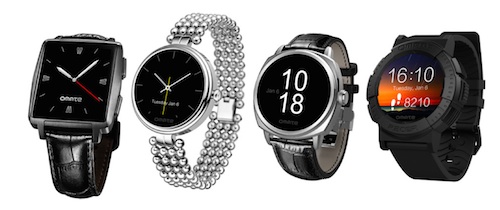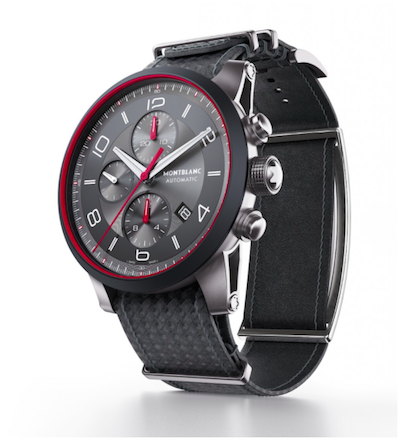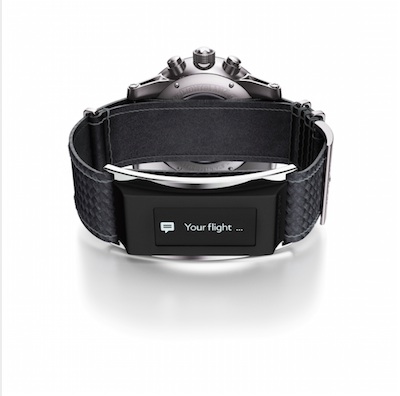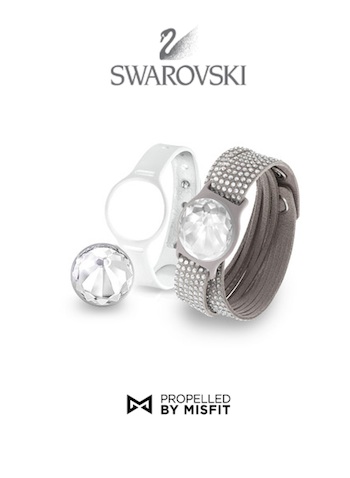Articles and News
Is Wearable Technology Relevant To Fine Jewelers? Some Big Players Say ‘Yes!’ | January 07, 2015 (0 comments)

New York, NY—While pundits are busy arguing whether the Apple watch will be a hit or miss—before the first one even goes on sale—heavy-hitting jewelry and watch brands Richline Group, Swarovski, and Montblanc have come out firmly in favor of smart watches and jewelry.
According to an article in Forbes, Fred Wilson, the venture capitalist behind Twitter and Tumblr, blogged that in his opinion, the wearable technology market would not live up to the hype, and as a result, the Apple Watch was not going to be have the same kind of success that the iPod, iPhone, and iPad enjoyed. But like the childhood game of “telephone,” Business Insider quickly translated “not the same kind of success” to “flop.” Then CNBC retweeted BI’s post, Wilson retaliated that wasn’t what he meant, and the debate took off as if the only two options for Apple’s watch are either a smash hit or a total failure.
Meanwhile, Richline, the Warren Buffett-owned conglomerate of jewelry manufacturers, is banking solidly that wearable technology will take off. Richline earlier this week announced partnerships with the Omate and CUFF brands of smart watches and jewelry respectively. The two brands will become an integrated part of Richline’s expansion into wearable technology jewelry and watches, a segment in which Richline intends to be a major player, says CEO Dennis Ulrich.
Richline and Omate signed a strategic partnership agreement for the exclusive distribution of certain Omate products. Said Ulrich, "In the smartwatch segment, two worlds are merging together: the traditional hundred-year-old watch industry and the high-tech hardware and software industry.” Likewise, the Richline-CUFF alliance is the first of its kind to pair an established jewelry supplier with a Silicon Valley player in the smart-jewelry space.
CUFF product functions include fitness and social notification, as well as a robust safety/security alert system that can send a distress signal to friends or family if the wearer is in trouble. For both products, Richline intends for fine jewelers to play a key role in distribution.

A selection of Omate watches. The brand just entered into a partnership with Richline.
Montblanc, meanwhile, is set to prove that luxury and technology can go hand in hand—or, in this case, on the same wrist. The first luxury watch brand to dip its toes into the wearable tech category, its forthcoming Timewalker Urban Speed “e-Strap” (reviewed by ATimelyPerspective.com’s Roberta Naas here) is made of a special leather and features a tracking device to slide on the back of the strap inside the wrist, while the watch face is a sporty but luxurious chronograph. The strap is designed for the brand’s new Urban Speed collection of watches, but it also can be purchased and worn independently, and the tracking device itself can slide on and off. The device will offer such features as calorie and step tracking, incoming calls, and more, connected through a user’s iOS or Android phone.
“I think Montblanc was so smart to develop the e-strap,” Naas told The Centurion. “That way, you can go out at night and not wear [the device part] to dress up.”


Montblanc is the first luxury brand to launch a smart watch. Its entry into the category features a removable tech device on the back of the strap, while the watch face remains a classic sporty chronograph.
Swarovski, meanwhile, is adding bling to wearable tech with a line of jewelry that also tracks the wearer’s activity, and a December article in The New York Times lists a host of high-tech jewelry, though to date none of them are luxury products or even originating in the industry. But Kevin Faro, co-founder of Silicon Valley electronics firm Mota, told the Times he’d love to have a well-known jewelry brand pick up his firm’s technology for use in a luxury jewel. Until then, his firm will launch it a Bluetooth-compatible ring this spring.

Swarovski Shine activity tracking crystal “Slake” bracelet, made in conjunction with activewear manufacturer Misfit. The tracker measures activities and sleep, and syncs with the user’s smartphone.
"Wearable technology will not be fad, it's an evolution," Ulrich told The Centurion. "We believe that relevant function added to fashion is very much a future consumer desire. These desirable functions will continue to expand, plus, as the tech scale decreases in size, it will become easier to integrate into almost any piece of jewelry no matter the style or price."
Naas predicts the smart watch will be much more important in the entry-luxury category—with price points from $2,000-$5,000—than the very high-end luxury category. “I think brands like Montblanc and others in that space will embrace it but brands like Patek and Audemars in the $10,000 and $20,000 range will stay true to their DNA,” she says. She also is careful to qualify luxury watch collectors from luxury watch customers. True collectors will be unaffected by smart watches, she says. Tech-minded collectors may add a smart watch for weekends, but beyond that she doesn’t see the category having much appeal for collectors of high-end timepieces.
But a luxury watch customer is someone who is merely looking for something different than what’s currently on their wrist, and they are more likely to be interested in adding a smart watch because it’s something new. Especially, she says, if they’re the kind of person who’s always first in line for the newest iPhone.
In the Times article, Daniel Gordon of Columbus, OH-based Diamond Cellar, reiterates his oft-repeated mantra to the industry, that the future of the jewelry trade hinges on its ability to embrace change, including adding wearable tech to retail showcases.
"Industries change, and if we've learned anything from the past it’s that innovation is vital to long term success. At Richline we have an innovation group specifically focused on analyzing the market and investigating all opportunities. It's now important that all industries learn how to integrate technological advancements into their product offerings," Ulrich said.
"It's been too many years where the fine jewelry stores has been losing share of disposable spending to the consumer electronics industry. All jewelry retailers now have a great opportunity to get a share of this fast growing market while additionally expanding their customer base to a broader range of customers who are early adaptors and looking to both invest in fine jewelry and have fun while doing so. We believe that wearables technology will be relevant for everyone's daily life," he added.
What about that pesky Apple watch that hasn’t hit stores yet? Forbes commentator Mark Rogowsky pointed out that each of the company’s revolutionary iOS devices—iPod, iPhone, iPad—was predicted to fail miserably when it launched, for reasons ranging from functionality to complexity. From its sales history, he extrapolates that 14 million Apple Watches will be sold in the first year, pointing out that the iPad sold 14.8 million in its first year; far more than predicted. With a starting price of $349—and a gold version reportedly to market for five to 10 times that price—14 million units sold would still obliterate any other smart watch competitor, he says, and make the Apple watch the defining product of the wearable tech category.
Whether Apple comes to define the territory or that falls to an existing watch brand, Naas sees the advance of smart watches as the rising tide that can help produce future watch lovers. “Young people wearing a FitBit may next transition to a smartwatch. Then that interest may trickle up into fine watches. If you’re looking at your wrist, eventually you are going to look at someone else’s wrist, and say ‘what a cool watch!’” says Naas.
There’s something else the tech-y pundits are missing. No less a fashion icon than Vogue magazine featured an Apple watch on its famous “Last Look” page, calling it “a tiny marvel.”
And how many jewelers wouldn’t want to sell even a part of 14 million watches?
Top image: The Apple Watch, by Eric Boman, Vogue, October 2014







